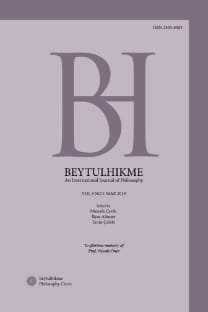İmkânsız Dünyalar
Impossible Worlds
___
- Berto, F. & Jago M. (2018). Impossible Worlds. The Stanford Encyclopedia of Philosophy. https://plato.stanford.edu/archives/fall2018/entries/impossible-worlds.
- Berto, F. (2017). Impossible Worlds and the Logic of Imagination. Erkenntnis, 82 (6), 1277–1297.
- Brun, J. (1997). Stoa Felsefesi. (Çev. M. Atıcı). İstanbul: İletişim Yayınları.
- Caston, V. (1999). Something and Nothing: The Stoics on Concepts and Universals. Oxford Studies in Ancient Philosophy, 17, 145-213.
- David, M. (1985). Nonexistence and Reid’s Conception of Conceiving. Grazer Philosophische Studien, 25 (1), 585-599.
- Dürüşken, Ç. (1991). Stoa Mantığı. Felsefe Arkivi, 28, 287-308.
- Ekren, U. (2005). Nesneler Teorisine Giriş, 1. Kutadgubilig Felsefe-Bilim Araştırmaları, 7, 43-52.
- Ekren, U. (2010). Alexius von Meinong ve Nesneler Teorisi. Kutadgubilig Felsefe-Bilim Araştırmaları, 17, 9-26.
- Jago, M. (2014). The Impossible an Essay on Hyperintentionality. Oxford: Oxford University Press.
- Leibniz, G. W. (2003). Monadoloji ya da Felsefenin İlkeleri. (Çev. O. Ürek). İstanbul: Biblos Yayınları.
- Lewis, D. (1973). Counterfactuals. Oxford: Basil Blackwell.
- Lewis, D. (1982). Logic for Equivocators. Noûs, 16 (3), 431-441.
- Lewis, D. (1986). On The Plurality of Worlds. Oxford: Basil Blackwell.
- Meinong A. (1904). The Theory of Objects. From Realism and the Background of Phenomenology. (Ed. R. Chilsom). Glencoe, Illinois: Free Press, 76-117.
- Nolan D. (1997). Impossible Worlds: A Modest Approach. Notre Dame Journal of Formal Logic, 38 (4), 535-572.
- Priest, G. (2005). Towards Non-Being the Logic and Metapysics of Intentionality. Oxford: Clarendon Press.
- Priest, G. (2008) An Introduction to Non-Classical Logic From If to Is. Cambridge: Cambridge University Press.
- Priest, G. (2016). Thinking the Impossible. Philosophical Studies, 173, 2649-2662.
- Reid T. (1997). An Inquiry into the Human Mind: On the Principle of Common Sense. (Ed. D. R. Brookes). Edinburgh: Edinburgh University Press.
- Routley, R. (1980). Exploring Meinong’s Jungle and Beyond. Canberra: Australian National University Central Printery.
- Routley, R. (1982). On What There Is Not. Philosophy and Phenomenological Research, 43 (2), 151-177.
- Salmon, N. (1998). Nonexistence. Noûs, 32 (3), 277-319.
- Sellars, J. (2010). Stoic Ontology and Plato’s Sophist. Bulletin of the Institute of Classical Studies, 107, 185-203.
- Yagisawa, T. (1988). Beyond Possible Worlds. Philosophical Studies, 53, 175-204.
- ISSN: 1303-8303
- Yayın Aralığı: 4
- Başlangıç: 2011
- Yayıncı: Mustafa Çevik
İşlevselci-Tip Özdeşliği Kuramı ve Bilinç Problemi
Nietzsche’nin Sokrates’i Kimdir?
İbn Sînâ ve Hegel Açısından Devletin Kurucu Unsuru
İnsanın Olgun Seçiminin Bir Sorunu Olarak Tekbaşınalık
Svitlana KHRYPKO, Ganna IATSENKO, Olena ALEKSANDROVA
Edebiyat, Kurmaca ve Gerçeklik
Sartre’da Vücudu Var Etmek: Duyguların Büyülü Dünyası
Hoşgörü Ahlâkı ya da Politiği: Hoşgörüye Teleoloji Yüklemek
KAMURAN GÖKDAĞ, SITKI KARADENİZ
Solitude as a Problem of Human’s Mature Choice
OLENA ALEKSANDROVA, Svıtlana KHYRIPKO, Ganna IATSENKO
Kınalızâde’nin Ahlâk-ı Alâî’sinde Devlet, Adalet ve Uluslararası İlişkiler
Changing Methodologies in Historicism: An Analysis for Rise and Fall of Rankean Historiography
